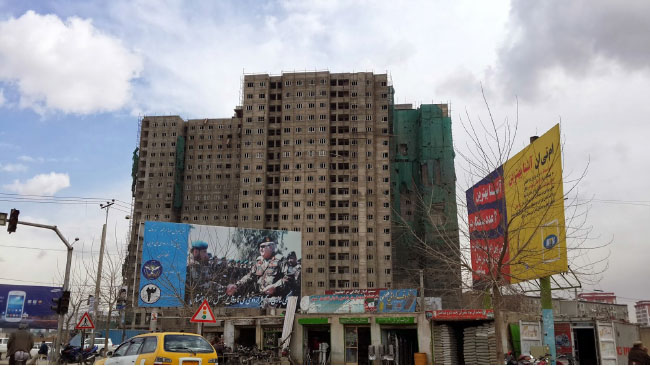Asia is a housewife in Kabul city. She says that the skyscrapers adjacent to her house put her in trouble adding that it is hard to reach out her daily chores and may abandon her home if the same trend continues. Violating one’s private sphere is not the only problem. Muhammad Zia Zamani, Deputy Director of Design and Implementation of Kabul Municipality, says that over 70 percent of Kabul city is not planned and the houses are built arbitrarily. In addition to jeopardizing life and property, there will be many other challenges for residents such as increasing population density, environmental problems, and privacy issues.
The story of Kabul city is the narration of collapse. Ancient Kabul constantly mentioned in myths, is only heard in stories. The war destroyed everything. As a result of bombardment and destruction, the city was in need of rehabilitation and development. But the city grew disproportionately and developed heterogeneously. The imported architecture and technology applied regardless of the rules of urban planning and the control of land marginalized the ancient architecture. Now residents of Kabul are alienated from their real city and feel nostalgic about the past days of Kabul.
One of the most important needs of the city is citizens’ housing. Currently, Kabul hosts millions of migrants from the countryside and returnees to their homeland. Constructing tall buildings will be an appropriate solution to the problem of Kabul city. That is, the lands will be utilized in better way, mainly in downtown and populous areas. But it should be noted that if the constructions are not planned properly, each buildings will be in the form of irregular dwelling – which is either isolated in the corner of a city or built very tall without standard. We observe tall buildings in Kabul which are built without considering the rights of neighbors or residents. Hence, the natural landscape is eroded, environmental pollution is increased, and the past traditions are left at stake.
Constructing tall buildings dates back to the beginning of the history of human civilization, but the Roman Empire for the first time began to develop Rome in vertical development of the city’s multi-story building. The desire for tall buildings in Afghanistan also has a historical background; the Forty Tower Building in Yakawlang district is one of the examples dating to the period of Kushani.
Tall buildings were formed to represent an authoritarian state, sometimes were the symbol of the development and economy, and sometimes to address the essential needs of a community for housing and services. The modern skyscrapers in the America’s major cities such as Chicago and New York and in many European cities were formed in 19th century following the industrialization and population growth for the optimal use of land. It also aimed to meet people’s demand for living and working in city center and to prevent from additional costs.
For the first time, such flats were built in small number in Afghanistan as housing project during the Communist regime supported by state and the Soviet Union. However, the past 16 years changed the feature of Kabul as hundreds of skyscrapers were built not out of social or developmental needs but to merely imitate the foreign countries. They are constructed for particular layer of society as luxury.
We confront two issues in Afghanistan: (1) Urban growth (2) Lack of resources (infrastructure, urban services, etc.). One of the issues that arises from unplanned urbanization is the problem of “urban sprawl” – which is defined as, “Uncoordinated growth: the expansion of community without concern for its consequences, in short, unplanned, incremental urban growth which is often regarded unsustainable.” It is also said to be “general consensus that urban sprawl is characterized by unplanned and uneven pattern of growth, driven by multitude of processes and leading to inefficient resource utilization.” This type of development in cities is the most unsustainable and undesirable. The theory of urban sprawl is in contrast with “compact city”. Compact city is an urban planning and urban design concept, which promotes relatively high residential density with mixed land uses. It is based on an efficient public transport system and has an urban layout which – according to its advocates – encourages walking and cycling, low energy consumption and reduced pollution. A large resident population provides opportunities for social interaction as well as a feeling of safety in numbers and “eyes on the street”. It is also arguably a more sustainable urban settlement type than urban sprawl. Achieving a compact city does not just mean increasing urban density per se or across all parts of the city. It means good planning to achieve an overall more compact urban form.
Home » Opinion » Collapse of Urban Values from the Top of Skyscrapers
Collapse of Urban Values from the Top of Skyscrapers
| Muhammad Amin Byani

